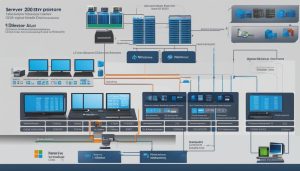Are you curious about the groundbreaking Windows NT 3.5 Server? Let’s dive into the details of this revolutionary operating system developed by Microsoft. Released in 1993, Windows NT 3.5 Server was a game-changer, offering a complete 32-bit architecture while retaining the familiar Windows 3.1 desktop environment. It paved the way for future advancements in server technology and set the stage for the popular Windows 2000.
Key Takeaways:
- Windows NT 3.5 Server was a major release of the Windows NT operating system.
- It combined the benefits of a 32-bit architecture with the user-friendly Windows 3.1 interface.
- Windows NT 3.5 Server introduced enhanced security measures and networking capabilities.
- The installation process involved booting from installation disks and following the wizard.
- Windows NT 3.5 Server marked a significant milestone in Microsoft’s operating system lineup.
Features of Windows NT 3.5 Server
Windows NT 3.5 Server brought forth a range of new features and enhancements that contributed to its popularity and success. One of the notable advancements was its transition to a 32-bit architecture, which provided improved performance and better memory handling compared to the previous 16-bit versions. This upgrade allowed users to harness the power of their hardware more efficiently, resulting in smoother operations and enhanced overall system capabilities.
In addition to the architectural improvements, Windows NT 3.5 Server offered enhanced networking capabilities, making it an ideal choice for businesses and organizations that relied on robust networking infrastructure. The operating system also introduced advanced security measures, including a permission framework and the ability to audit security-related events. These features provided users with more control over their server environment and helped to safeguard critical data and resources.
Windows NT 3.5 Server retained the user-friendly graphical user interface (GUI) of Windows 3.1, ensuring that users who were already familiar with the Windows environment could easily navigate and operate the system. This user-friendly interface, combined with compatibility with a wide range of third-party software, made Windows NT 3.5 Server a flexible and versatile operating system that catered to the diverse needs of users.
| Feature | Description |
|---|---|
| 32-bit Architecture | Improved performance and memory handling |
| Enhanced Networking | Advanced networking capabilities |
| Enhanced Security | Permission framework and security event auditing |
| User-Friendly GUI | Similar interface to Windows 3.1 |
| Third-Party Software Compatibility | Support for a wide range of software |
Overall, Windows NT 3.5 Server introduced a host of notable features and improvements that set the stage for the future evolution of the Windows NT operating system. Its robust architecture, advanced networking capabilities, enhanced security measures, and user-friendly interface made it a reliable choice for businesses and individuals alike.
History of Windows NT 3.5 Server
Windows NT 3.5 Server has a rich history that traces back to Microsoft’s collaboration with IBM in the 1980s to develop the OS/2 operating system. However, Microsoft ultimately shifted its focus towards advancing the Windows platform and discontinued its involvement in OS/2. This decision led to the development of Windows NT, with version 3.5 being a major milestone in its evolution.
In 1991, Windows NT 3.5 Server was publicly demonstrated at Comdex, generating excitement among technology enthusiasts. Two years later, in 1993, it was released as the first complete 32-bit operating system that retained the familiar Windows 3.1 desktop environment.
Windows NT 3.5 Server laid the foundation for future releases, including Windows NT 4.0 and Windows 2000, which became widely popular in the industry. Its transition from the 16-bit architecture of previous Windows versions to a fully 32-bit system showcased Microsoft’s commitment to delivering cutting-edge technology and paved the way for the advancements that followed.
Key Milestones in the History of Windows NT 3.5 Server
| Year | Event |
|---|---|
| 1991 | Public demonstration of Windows NT 3.5 Server at Comdex |
| 1993 | Official release of Windows NT 3.5 Server |
| 2000 | End of support for Windows NT 3.5 Server |
Windows NT 3.5 Server was a significant leap forward in the evolution of server technology. Its introduction of a complete 32-bit architecture and enhanced security features laid the groundwork for future advancements, making it a crucial milestone in Microsoft’s operating system lineup.
Although Windows NT 3.5 Server is no longer supported, its impact and influence continue to be felt in the world of server technology. The release of this groundbreaking operating system set the stage for the development of subsequent versions and reinforced Microsoft’s position as a leader in the industry.
Note: Image represents the historical significance of Windows NT 3.5 Server in the evolution of server technology.
Installation and System Requirements for Windows NT 3.5 Server
When installing Windows NT 3.5 Server, it is essential to ensure that your system meets the necessary requirements. This will ensure optimal performance and stability. The installation process involves booting from installation disks and following the installation wizard, which will guide you through the necessary steps.
Before proceeding with the installation, it is important to consider the system requirements. Windows NT 3.5 Server requires an Intel 80386 processor or compatible, at least 32 MB of RAM, and a minimum of 100 MB of free disk space. It supports the IA-32 architecture, as well as the Alpha and MIPS processors.
| Minimum System Requirements for Windows NT 3.5 Server: | |
|---|---|
| Processor | Intel 80386 or compatible |
| RAM | At least 32 MB |
| Free Disk Space | Minimum 100 MB |
| Architecture | IA-32, Alpha, MIPS |
During the installation process, you will have the opportunity to select various options, such as disk partitioning and network configuration. It is essential to choose the appropriate options based on your specific requirements. Windows NT 3.5 Server provides a comprehensive user guide that can assist you in navigating through the installation process and making informed decisions.
By following the installation guide and ensuring that your system meets the minimum requirements, you can successfully install Windows NT 3.5 Server and take advantage of its advanced features and capabilities.
Conclusion
As we conclude our exploration of Windows NT 3.5 Server, it’s important to note that this operating system has reached the end of its support. After December 31, 2000, Microsoft shifted its focus to newer iterations of Windows NT. However, the impact of Windows NT 3.5 Server cannot be overlooked.
Windows NT 3.5 Server was available in two editions: Windows NT 3.5 for workstations and Windows NT 3.5 Advanced Server for servers. This versatility allowed users to select the edition that best suited their needs.
For those seeking to migrate from Windows NT 3.5 Server to a more modern operating system, Microsoft provided a comprehensive migration guide. This guide served as a valuable resource to facilitate a smooth transition and ensure the seamless continuation of operations.
Although Windows NT 3.5 Server is no longer supported, its impact cannot be underestimated. It paved the way for future advancements in the Windows NT family and played a crucial role in the evolution of server technology. As we bid farewell to Windows NT 3.5 Server, we acknowledge its legacy and look forward to the innovations that lie ahead.
FAQ
What is Windows NT 3.5 Server?
Windows NT 3.5 Server is a major release of the Windows NT operating system developed by Microsoft. It is a complete 32-bit operating system that retained the familiar Windows 3.1 desktop environment.
What are the features of Windows NT 3.5 Server?
Windows NT 3.5 Server introduced a 32-bit architecture for better performance and memory handling. It supported multiple processors, had improved networking capabilities, and included enhanced security measures. It also had a graphical user interface (GUI) similar to Windows 3.1 and compatibility with third-party software.
What is the history of Windows NT 3.5 Server?
Windows NT 3.5 Server had its roots in the development of the OS/2 operating system, but Microsoft decided to prioritize Windows and discontinued its OS/2 development responsibilities. It was first publicly demonstrated at Comdex 1991 and released in 1993, marking a transition from 16-bit to 32-bit architecture.
What are the installation and system requirements for Windows NT 3.5 Server?
To install Windows NT 3.5 Server, you need to boot from installation disks and follow the installation wizard. The system requirements include an Intel 80386 processor or compatible, at least 32 MB of RAM, and a minimum of 100 MB of free disk space. It supports IA-32, Alpha, and MIPS processors.
What is the support and future of Windows NT 3.5 Server?
Windows NT 3.5 Server reached the end of its support on December 31, 2000, and was succeeded by newer versions of Windows NT. It was available in two editions: Windows NT 3.5 for workstations and Windows NT 3.5 Advanced Server for servers. Microsoft provided a migration guide for those looking to transition to newer operating systems.
Janina is a senior specialist in information technology


